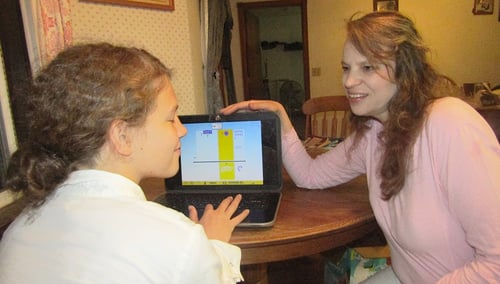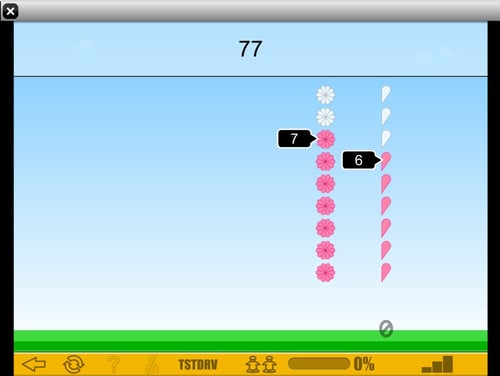By: Suzie Murphy
“Look, honey, 4 + 6 = 10, and 6 + 4 = 10, always, always, always! It will never change today, tomorrow, or the next day! Now, what is 6 + 4?”
My 11 year-old daughter looked at me perplexed. “Ummmm … let me see …” she said, as she tried to puzzle it out in her head.
“Honey,” I said, “here, look at these blocks. See the 4 block? See the 6 block? Now watch how I put these together to equal the 10 block.”
My daughter shook her head and said, “Mom, you don’t seem to understand that I just don’t get it. How can I ever learn it if I don’t get it?” As a homeschool mom, I was afraid that my worst fears were going to be realized: my daughter would never, ever understand math.
I already knew that my daughter had dyslexia and dysgraphia, and I knew that she had difficulties with math, and through my research, I discovered that these difficulties had a name: dyscalculia. I was part of a yahoo group for parents of children with dyslexia, and the topic of math often came up.

Suzie's daughter, pictured above, has dyslexia and dysgraphia. Photo credit: Essence Photography.
“What math program do you use to help your child?” mothers would commonly ask. “My child also struggles with understanding and remembering math facts. Is there anything that can help her?”
My daughter and I had tried every possible curriculum, every possible teaching method, every possible manipulative. We had tried flashcards, stories about math facts, timed tests, fun math games, all to no avail. No matter what, we could not get those math facts to stick, and besides that, she would say, “Mom, I just don’t understand it. It doesn’t make any sense to me.”
It was the same every single day for the past couple of years, and we weren’t making any progress in math at all. It was as though we were stuck in the snow, without a shovel, without sand, just continually revving the engine, digging us in deeper in the same spot, unable to move forward even an inch. I felt like crying. How could we do all of these workbooks, year after year, and still never progress? It felt so hopeless, and I had no idea how to help her.
Our struggles with teaching math were not the result of any lack of training or education on the part of my husband and I. We came to homeschooling with pretty extensive backgrounds and advanced degrees in speech language pathology, special education, and early childhood education, as well as library media science. My husband wrote his master’s paper on dyslexia, and so we knew that as with dyslexia, that dyscalculia probably caused the brain to be wired in different ways, and that in order to successfully teach our daughter math, we needed to find the proper tools, the proper curriculum. It seemed like every curriculum approached math in the same way, but was perhaps packaged a bit differently.
I had researched every possible method to help my daughter, and yet somehow I was failing her. I felt as though she would go through life never being able to follow a recipe, to balance her checkbook, to count her change, to get a job. I was at my wit’s end.

More math worksheets were not the answer for helping Suzie's daughter understand math.
It seemed that there were no answers out there for our kids. The only possible answers to remediate dyscalculia, a math disability, were these wildly expensive classes offered in another state. However, even these professors had never developed a set, daily curriculum. Although I could not afford to take these classes, I became determined to learn their methods. They had some free videos, and I studied them very carefully.
It was while I was looking at these videos, that a TED Talk appeared in the suggested videos section of my computer screen. It happened to be the developer of ST Math from MIND Research Institute. I could hardly believe what I was hearing. It was as though a total answer to prayer was unfolding in front of me: someone had the answer to dyscalculia! Someone with dyslexia had, together with other researchers, developed an entire program just for children like my daughter. I was so excited that I could hardly contain myself, and I was bursting with joy.
My husband and I decided to enroll all of the kids in the pilot program for ST Math: Homeschool, just to see how they liked it, and how it might help them. Our other children were twelve, nine, seven and four years old at this time, and two of them also have dyslexia.
We were hooked! The kids were begging to do ST Math, and there were all kinds of epiphanies occurring on a daily basis, with kids exclaiming, “Oh, I get it now!” and “Oh, wow, I never understood that before!”

Suzie's daughter and Suzie work together on ST Math.
Our daughter with dyscalculia completed an entire ST Math grade level, and is almost done with her second grade level. For the first time she is understanding math, which makes both of us feel excited. She is experiencing daily success with ST Math, and we feel confident that she now has the proper tools to master higher level math. I no longer feel that we are just spinning our wheels, and our daughter feels proud of her accomplishments both in ST Math and in her traditional math workbook.
Here is what I see in ST Math that makes a difference:

The petal place value game from ST Math helped Suzie's daughter understand multi-digit numbers.
Now we have been using ST Math for over a year, and we are enrolling our youngest, who is three years old because he is begging to do ST Math, and we found that he could solve some of the problems at the kindergarten level. We just had our 8th grader tested on the Iowa Basics Test, and he tested at the college level in his math skills! Our other two daughters with dyslexia have also made wonderful and amazing progress in ST Math, and they much prefer doing ST Math to any workbook.
ST Math is the first daily math curriculum available that directly remediates dyscalculia. Not only does it remediate it, but I believe, that like a circuit board, it finds those wires in the brain which are disconnected, and makes them connect. Perhaps future research will show that changes take place in a person’s brain when the individual has completed a grade level of ST Math. I think it actually changes the way an individual conceptualizes math, and this leads to increased speed in computation and calculation, and better performance overall.

The Murphy kids. Photo credit: Essence Photography.
ST Math helps students conceptualize and understand concepts fully, filling in any holes they may have in their math understanding. This type of learning is beneficial for all students. Looking at my child who does not have a learning disability, he found ST Math very easy initially, but eventually found it very challenging. The program reached a level of rigor for him at his pace.
I'm grateful to the researchers of ST Math—they found a way to make math into some fun and exciting games that all kids can enjoy!

MIND Research Institute welcomes guest blogs that highlight best practices in math education, blended learning and innovative learning strategies that inspire students at all ages.
Comment